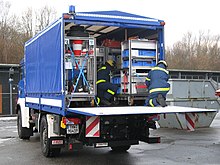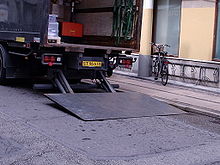Tail lift
A tailgate of a truck (or trailer ) is referred to as a tail lift (synonym: tail lift) , which can be lowered to the level of the road for easier loading and unloading of freight . It is often referred to as a lifting platform , although this term is much more comprehensive and z. B. also extends to lifting platforms in vehicle workshops . Usually the drop side at the rear of the vehicle is replaced by the tail lift. But there are also special constructions for the vehicle sides.
General
The fixed tail lift can be tilted from vertical (driving position) to horizontal (loading position) and then lowered or raised horizontally. This movement is usually directly (parallelogram) or indirectly (vertical lift) by hydraulic cylinders reached, the hydraulic pump is electrically, or by a power take-off is driven (pressure equalization cylinder) in the aggregate.
Tail lifts, divided into different weight classes (500 kg, 750 kg, 1 t, 1.5 t, 2 t, 2.5 t, 3 t, 4 t, 5 t, 6 t, 7.5 t, 9 t), allow heavy goods to be loaded and unloaded, even if neither a loading ramp nor a forklift is available. Trucks with a tail lift are mostly used in local freight transport for home deliveries. Palletized goods can be moved with a pallet truck from the truck bed to the tail lift , which then lowers the pallet to the level of the road. From there the pallet can then be transported on by road. The tail lift as part of the body does not require any additional doors if it is flush with the body frame.
Functionality and operation
The platform is first brought to a level with the regular loading area after its position has been changed by 90 degrees. The load is then brought onto the platform, which is now lowered to floor level, where the load can leave the vehicle.
It is operated either from the loading area, using foot switches or buttons on the rear of the truck, or using controls on the side of the vehicle.
In loading zones , in particular , vehicle drivers must ensure that there is sufficient space for lowering, loading and unloading the tail lift.
If a tail lift is regularly loaded with goods that are heavier than it is designed for the weight class, material fatigue can occur. The tail lift can then sag during a loading process.
Special forms
A special form of a tail lift is the "foldable" lift. While a tail lift normally closes the rear opening of the body, a foldable lift is not part of the body. It can be folded in the middle and then, in this shortened state, folded or retracted below the vehicle body. Compared to a conventional tail lift, this has the advantage that the truck can also dock on a loading ramp without the tail lift having to be folded down each time. In practice, tail lifts are mostly found on smaller trucks, as they are mainly used in distribution traffic in local freight traffic, because the missing rear doors make work easier here. Foldable tail lifts are always to be found where versatility is required, and the additional effort caused by folding or unfolding during loading and unloading is negligible. Disadvantages of the foldable tail lift are only increased maintenance and care costs due to the folding and driving mechanics or hydraulics.
There are also vertical lifts that are generally used in motorsport and particularly often in Formula 1 . With these you can z. B. load two vehicles on top of each other (double decker), which are via the vertical lift from the z. B. Let the trailer drive out.
safety
A tail lift must be visible on every side so that traffic does not drive into the tail lift when it is not in the driving position. This is done using flags on the underside of the platform and flashing lights on the top of the extended platform. There are reflective warning strips attached to the platform on the sides.
An underrun protection , either three-part or one-part, is also mandatory. In addition, an annual UVV test according to BGR 500 and manufacturer information must be carried out (such as a TÜV test), i.e. a visual and functional test of all hoses, screw connections, bolts, support arms, the warning device, the load with weight, signs, operating instructions, lifting cylinders and tilt cylinders as well as an oil change.
Manufacturer
The most famous tail lift manufacturers are:
- AMF (production discontinued)
- Behrens Loading Systems (300 tail lifts / year)
- Bear Cargolift
- Dautel (3,500 tail lifts / year)
- DEL UK (6,500)
- Dhollandia (35,000 tail lifts / year)
- Easyloader tail lifts for panel vans up to 3.5 t (250 tail lifts / year)
- Gerd Bär (Bär Cargolift; 15,260 tail lifts / year 2018)
- Kyokuto Kaihatsu
- QualiXperts (patent holder electromechanical drive)
- Palfinger (Palgate, Ratcliff, MBB; 14,000 tail lifts / year)
- ShinMaywa
- Sörensen (2,000 tail lifts / year)
- Zepro (22,000 tail lifts / year)
- Zikun (side tail lifts)




